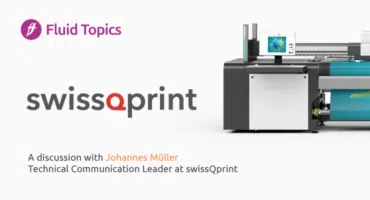Johnson Controls International (JCI) is the multinational leader of smart building technology. Comprised of 80 brands, JCI harnesses AI to help their customers create safer, more sustainable spaces. After acquiring security systems company, Tyco, JCI took advantage of this transition period to implement a modern and cohesive content strategy to seamlessly manage their growing portfolio.
We sat down with Nelson Abbey, Principal Information Developer at JCI to discuss the details of this shift and how Fluid Topics helped them quickly launch the Knowledge Exchange to meet their evolving and ambitious content needs.
The Challenge
Integrating new teams and products requires the harmonization of different processes, protocols, and tools while keeping up with the status quo. This was exactly the mission that JCI’s documentation team found ahead of them following their latest merger. They needed to quickly reorganize and unify content operations to maintain their impressive writing and publishing schedule across all 80 brands.
JCI aimed to migrate their content production to Ixiasoft (now Madcap Ixia CCMS) to leverage the benefits of structured content. At the same time, they faced the challenge of handling some existing legacy PDFs. As a result, they sought a solution that could seamlessly integrate with their existing content tools and centralize content from all sources and formats.
In a nutshell
The challenges
- Unifying content from 80 brands into a single content management process.
- Streamlining content publishing to 60+ websites and platforms like Salesforce and Sitecore.
- Enforcing specific user access rules per document and role.
The results
- A unified knowledge center, no matter the initial source and format.
- 25 documentation portals deployed in record time.
- Real-time publishing directly from Ixiasoft to all the channels.
- Centralized access rules management as well as SSO integrations with other platforms’ authentication systems, such as Salesforce.
The Solution
Post-merger, JCI evaluated several Content Delivery Platforms (CDPs) to manage their needs. They chose Fluid Topics for its turnkey solution concluding that its bespoke platform provided the ideal components to guarantee continuous content availability. “Fluid Topics enhanced our operations by unifying our content and centralizing our publishing, allowing us to instantly communicate about 1 million products across 60 websites and 25 portals. The time saved and the improved user experience? That’s true value,” said Nelson Abbey.
Several other factors led JCI to choose Fluid Topics, including:
Fast implementation: The implementation went smoothly. JCI published the first five portals the same year as the merger, before launching 20 other portals at the impressive rate of one or two a month. Since Fluid Topics ingests content in any format, there was no requirement to convert everything to DITA beforehand. In fact, the legacy content became accessible immediately, allowing the documentation team to manage the content migration at their own pace.
Out-of-the-box, customizable solution: Fluid Topics provides all content delivery features and full-fledged documentation portals out-of-the-box, while the user-friendly Designer allowed JCI’s team to effortlessly create and customize their different portals through an intuitive WYSIWYG editor.
Low dependency on IT support: Fluid Topics safely integrates and automates all publishing procedures without the need for IT intervention, allowing teams to focus on writing instead of managing systems, thus reducing their reliance on IT. Abbey highlighted just how crucial this was for his team, “We have an enormous amount of content spanning 80 different brands, so our writing teams needed a solution that allows them to remain efficient and productive. Heavy IT intervention would have been too much of a hindrance.”
Highly scalable and flexible: A quickly evolving company needs tools that grow with it. With Fluid Topics, JCI can seamlessly create multiple front-end turnkey portals leveraging the same central administration console and its single knowledge center. Adapting to changing business needs, like grouping products or brands under a unique portal or granting access to specific product information in a new territory, can be easily handled from the administration console. “We split four product lines that were initially grouped under one into four distinct portals in just a few days. It would have taken us a year if we had to do it with websites”, said Abbey.
Access rights management: JCI was able to define user profiles across their portals. This is essential as the company serves many different teams (tech, marketing, sales), and over 50% of their audience is either internal or partners. Fluid Topics’ access rights management helps JCI connect their portals to their active directories so only authorized users can access certain documentation. Credentials are automatically taken from other systems, unifying the authentication process for authorized partners.
Integration: Smooth integration is key for JCI to deliver content to 60 websites and Salesforce. JCI found that Fluid Topics adapted perfectly to their existing corporate architecture thanks to its easy-to-use APIs. As their technical content feeds many different systems and departments, it was vital to have information on content at their fingertips.
“We managed to build 25 documentation portals that combine over 4000 documents in DITA and 30,000 in other formats.” Nelson Abbey
About Johnson Controls

Johnson Controls offers the world’s largest portfolio of building technology, software and services. Supported by a team of more than 100,000 dedicated employees working across 150 countries, we’re helping customers achieve their sustainability goals and power their mission.
“Fluid Topics provided significant value by unifying our content and centralizing our publishing, allowing us to instantly communicate about 1 million products across 60 websites and 25 portals.” Nelson Abbey
The Results
Fluid Topics helped JCI quickly build a powerful system to streamline their documentation management. Nelson Abbey said it best when he remarked that “thanks to Fluid Topics, we managed to build 25 documentation portals that combine over 4000 documents in DITA and 30,000 in other formats. Our ability to make the right documentation instantly available to users is night and day with how we were previously working.”
Their documents span 50 languages and are connected to 60 websites, allowing JCI to properly communicate their high-quality documentation to users.
What’s Next?
As the company continues to evolve, JCI has identified potential opportunities to expand their use of Fluid Topics for their field technicians. The 1000s of field engineers need offline access to content to receive the proper support. Fluid Topics allows users to access offline content with a consistent and seamless experience thanks to progressive Web App technology.
Furthermore, Nelson Abbey was pleased to report that JCI is quickly advancing on a new innovative project at the heart of the company’s AI strategy. “Fluid Topics’ AI-ready platform provides us with the foundation needed to fast-track our progress and swiftly launch key Generative AI initiatives.” This project underscores one of JCI’s core reasons for choosing Fluid Topics: they were and still are confident in our vision and the roadmap that we routinely deliver. Abbey confirmed this stating, “Fluid Topics has consistently ensured their product evolves with the latest best practices, anticipated trends, and provided technological excellence. In doing so, they proved to be more than a tech leader—they became a trusted business partner.”
What’s a Content Delivery Platform?
Content Delivery Platforms (CDP) like Fluid Topics collect all the documentation owned by an organization (no matter the initial source and format), unify it and distribute the relevant content to all endpoints (product websites, documentation portals, community sites, etc.), devices, and applications, in-context with the users’ needs and environment. CDPs are connected in real-time to the sources of information and ensure the documentation is live and accurate on the user side.
You might also be interested in

How swissQprint Streamlined their Service Organization with Self-Service Documentation

Vaisala Delivers a Personalized Content Experience to Its Customers and Employees Worldwide

